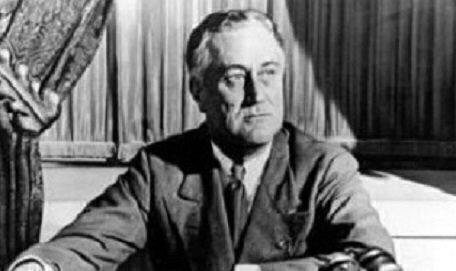On this day in 1941, President Franklin D. Roosevelt orders Dr. Vannevar Bush to move forward with a top-secret project that led to the world's first atomic bombs. Over the following four years, the Manhattan Project was shrouded in secrecy, despite more than 100,000 people working on it.
 At that key meeting in Washington was Henry Wallace, then the Vice President, who had been briefed in July 1941 about discussions that started in 1939 after FDR received a letter from Albert Einstein and Leo Szilard about the potential of nuclear research's military use. The project's secrecy was so great that Harry Truman, who replaced Wallace as Vice President in 1945, had to be briefed on it after he became President after Roosevelt's death.
At that key meeting in Washington was Henry Wallace, then the Vice President, who had been briefed in July 1941 about discussions that started in 1939 after FDR received a letter from Albert Einstein and Leo Szilard about the potential of nuclear research's military use. The project's secrecy was so great that Harry Truman, who replaced Wallace as Vice President in 1945, had to be briefed on it after he became President after Roosevelt's death.
According to accounts of the meeting, President Roosevelt told Bush to find out how much it would cost to build the bomb, if it could be built, including the costs of construction facilities. Bush also updated Roosevelt on the work of British and American scientists. The meeting was one of several decisions Roosevelt made in secret about the bomb in that time peiod.
At the October 9 meeting, Roosevelt also indicated he would find funding for the project, which became much simpler after the United States officially entered World War II two months later. In January 1942, President Roosevelt officially approved the project to make the first atomic weapons.
General Leslie Groves was put in charge of the massive effort, which included the federal government seizing land in Oak Ridge, Tennessee to build a production facility housing about 75,000 workers. Within the government, only a handful of people knew the totality of the Manhattan Project, including a core group within the Executive Branch.
After the war, Groves disclosed that some people in Congress also knew the project's importance, such as the leaders of the House and Senate. They were able to get funding for the Manhattan Project buried inside appropriations bills as needed, telling other members they were part of the war effort and beyond questioning. One Senator who had questions about the unknown project's expenses was then-Senator Harry Truman, who was persuaded to drop his investigation by the Secretary of War, Henry Stimson.
In all, the United States spent an estimated $2 billion on a project that employed more than 120,000 people to build a nuclear weapon. The critical field test of a nuclear device was scheduled for July 16, 1945, to coincide with the arrival of President Truman at the Potsdam Conference.
The test bomb was placed on a 100-foot tower near Alamogordo, New Mexico. Government officials and scientists weren’t sure what to expect when the device called Gadget was detonated at 5:30 a.m. The explosion was about four times stronger than anticipated by some scientists at Los Alamos; Robert Oppenheimer later remarked the blast reminded him of a passage from Hindu text, the Bhagavad-Gita: "Now I am become Death, the destroyer of worlds."
Within a month, the United States military had dropped two atomic bombs on Japan, facilitating the end of World War II and the start of the Cold War. Truman had told Soviet leader Joseph Stalin about a new weapon of mass destruction while at Potsdam; the Soviets already knew secretly about the American program and were working on their own atomic research.







